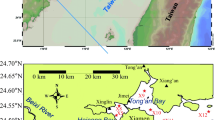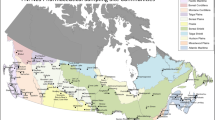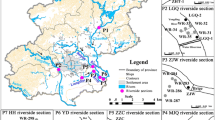Abstract
Surface waters from five districts in the inner city of Beijing were collected for analysis of 43 target compounds of pharmaceuticals and personal care products (PPCPs) to understand the spatial distribution patterns of different groups of PPCPs in the central urban area of a metropolitan city characterized by many hospitals and public parks. The total concentrations of PPCPs showed large spatial variability, ranging from 71.1 to 2400 ng/L. The x-ray contrast medium iopromide was the compound with the highest concentrations. Pharmaceuticals showed similar spatial distributional patterns with large hospitals. Positive correlations between iopromide and pharmaceuticals were observed. In contrast, in general there is no correlation between iopromide and personal care products. The concentrations of PPCPs in the landscape waters were not high but were characterized by high proportions of acidic, nonsteroidal anti-inflammatory drugs with low or even negative removal efficiencies in the WWTP in Beijing, suggesting that the reclaimed water irrigation can be another source of PPCPs in surface waters in the inner city of Beijing.





Similar content being viewed by others
References
Birkett JW, Lester JN (2003) Endocrine disrupters in waste water and sludge treatment processes. CRC Press, Florida
Caldwell DJ, Mastrocco F, Anderson PD, Länge R, Sumpter JP (2012) Predicted-no-effect concentrations for the steroid estrogens estrone, 17β-estradiol, estriol, and 17α-ethinyl estradiol. Environ Toxicol Chem 31(6):1396–1406
Camacho-Muñoz D, Martín J, Santos JL, Aparicio I, Alonso E (2012) Effectiveness of conventional and low-cost wastewater treatments in the removal of pharmaceutically active compounds. Water Air Soil Pollut 223:2611–2621
Campbell CG, Borglin SE, Green FB, Grayson A, Wozei E, Stringfellow WT (2006) Biologically directed environmental monitoring, fate, and transport of estrogenic endocrine disrupting compounds in water: a review. Chemosphere 65:1265–1280
Chen H, Li X, Zhu S (2012) Occurrence and distribution of selected pharmaceuticals and personal care products in aquatic environments: a comparative study of regions in China with different urbanization levels. Environ Sci Pollut Res 19:2381–2389
Dai G, Wang B, Huang J, Dong R, Deng S, Yu G (2015) Occurrence and source apportionment of pharmaceuticals and personal care products in the Beiyun River of Beijing, China. Chemosphere 119:1033–1039
Dai G, Wang B, Fu C, Dong R, Huang J, Deng S, Wang Y, Yu G (2016) Pharmaceuticals and personal care products (PPCPs) in urban and suburban rivers of Beijing, China: occurrence, source apportionment and potential ecological risk. Environ Sci Proc Impact 18:445–455
Daughton CG (2003) Cradle-to-cradle stewardship of drugs for minimizing their environmental disposition while promoting human health. I. Rationale for and avenues toward a green pharmacy. Environ Health Perspect 111:757–774
Done HY, Halden RU (2015) Reconnaissance of 47 antibiotics and associated microbial risks in seafood sold in the United States. J Hazard Mater 282:10–17
Drewes JE, Fox P, Jekel M (2001) Occurrence of iodinated X-ray contrast media in domestic effluents and their fate during indirecxt potable resuse. J Environ Sci Health Part A 36:1633–1645
European Commission (2003) Technical guidance document on risk assessment. Part II. European Commission Joint Research Centre (EUR20418EN/2)
Gagne F, Blaise C, Andre C (2006) Occurrence of pharmaceutical products in a municipal effluent and toxicity to rainbow trout (Oncorhynchus mykiss) hepatocytes. Ecotoxicol Environ Safe 64:329–336
Gao J, Huang J, Chen W, Wang B, Wang Y, Deng S, Yu G (2016) Fate and removal of typical pharmaceutical and personal care products in a wastewater treatment plant from Beijing a mass balance study. Front Environ Sci Eng 10:491–501
Hernando MD, Mezcua M, Fernández-Alba AR, Barceló D (2006) Environmental risk assessment of pharmaceutical residues in waste water effluents, surface waters and sediments. Talanta 69:334–342
Huang YQ, Wong CK, Zheng JS, Bouwman HBR, Wahlström B, Neretin L, Wong MH (2012) Bisphenol A (BPA) in China: a review of sources, environmental levels, and potential human health impacts. Environ Int 42:91–99
Liu JL, Wong MH (2013) Pharmaceuticals and personal care products (PPCPs): a review on environmental contamination in China. Environ Int 59:208–224
Liu YY, Blowes DW, Groza L, Sabourin MJ, Ptacek CJ (2014) Acesulfame-K and pharmaceuticals as co-tracers of municipal wastewater in a receiving river. Environ Sci Proc Impact 6:2789–2795
Llorens-Blanch G, Badia-Fabregat M, Lucas D, Rodriguez-Mozaz S, Barcelo D, Pennanen T, Caminal G, Blanquez P (2015) Degradation of pharmaceuticals from membrane biological reactor sludge with Trametes versicolor. Environ Sci Proc Impact 17:429–440
Loos R, Tavazzi S, Mariani G, Suurkuusk G, Paracchini B, Umlauf G (2017) Analysis of emerging organic contaminants in water, fish and suspended particulate matter (SPM) in the Joint Danube Survey using solid-phase extraction followed by UHPLC-MS- MS and GC–MS analysis. Sci Total Environ 607–608:1201–1212
Luo Y, Lin X, Rysz M, Wang Y, Zhang H, Alvarez PJJ (2011) Occurrence and transport of tetracycline, sulfonamide, quinolone, and macrolide antibiotics in the Haihe River Basin, China. Environ Sci Technol 45:1827–1833
Miege C, Choubert JM, Ribeiro L, Eusebe M, Coquery M (2009) Fate of pharmaceuticals and personal care products in wastewater treatment plants-Conception of a database and first results. Environ Pollut 157:1721–1726
NRMMC (2008) Australian guidelines for water recycling: augmentation of drinking water supplies (Phase 2). Natural Resource Management Ministerial Council, Environment Protection and Heritage Council, National Health and Medical Research Council. Canberra, p 38
Oketola AA, Fagbemigun TK (2013) Determination of nonylphenol, octylphenol and bisphenol-A in water and sediments of two major rivers in Lagos, Nigeria. J Environ Protect 4:38–45
Richardson BJ, Lam PKS, Martin M (2005) Emerging chemicals of concern: pharmaceuticals and personal care products (PPCPs) in Asia, with particular reference to Southern China. Mar Pollut Bullet 50:913–920
Steger-Hartmann T, Lange R, Schweinfurth H (1999) Environ-mental risk assessment for the widely used iodinated X-ray contrast agent iopromide (ultravist). Ecotoxicol Environ Safe 42:274–281
USEPA (2014) Nonylphenol (NP) and nonylphenal ethoxylates (NPEs) Action Plan. February 2014
Verlicchi P, Al Aukidy M, Zambello E (2012a) Occurrence of pharmaceutical compounds in urban wastewater: removal, mass load and environmental risk after a secondary treatment: a review. Sci Total Environ 429:123–155
Verlicchi P, Al Aukidy M, Galletti A, Petrovic M, Barceló D (2012b) Hospital effluent: investigation of the concentrations and distribution of pharmaceuticals and environmental risk assessment. Sci Total Environ 430:109–118
Williams RJ, Johnson AC, Keller VDJ, Young AR, Holmes MGR, Wells C, Gross-Sorokin M, Benstead R (2008) A national, GIS-based risk assessment for intersex in fish arising from steroid oestrogens–England and Wales. In: SETAC Europe 18th Annual Meeting, Warsaw, 25–29th May 2008. Society of Environmental Toxicology and Chemistry
Xu W, Yan W, Huang W, Miao L, Zhong L (2014) Endocrine-disrupting chemicals in the Pearl River Delta and coastal environment: sources, transfer, and implications. Environ Geochem Health 36:1095–1104
Yang X, Chen F, Meng F, Xie Y, Chen H, Young K, Luo W, Ye T, Fu W (2013) Occurrence and fate of PPCPs and correlations with water quality parameters in urban riverine waters of the Pearl River Delta, South China. Environ Sci Pollut Res 20:5864–5875
Yang Y-Y, Liu W-R, Liu Y-S, Zhao J-L, Zhang Q-Q, Zhang M, Zhang J-N, Jiang Y-X, Zhang L-J, Ying G-G (2017) Suitability of pharmaceuticals and personal care products (PPCPs) and artificial sweeteners (ASs) as wastewater indicators in the Pearl River Delta, South China. Sci Total Environ 590–591:611–619
Yargeau V, Lopata A, Metcalfe C (2007) Pharmaceuticals in the Yamaska River, Quebec, Canada. Water Qual Res J Canada 42:231–239
Young WF, Whitehouse P, Johnson I, Sorokin N (2002) Proposed predicted-no-effect- concentrations (PNECs) for natural and synthetic steroid oestrogens in surface waters. Bristol, Environmental Agency
Yu Y, Huang Q, Wang Z, Zhang K, Tang C, Cui J, Feng J, Xi Peng (2011) Occurrence and behavior of pharmaceuticals, steroid hormones, and endocrine disrupting personal care products in wastewater and the recipient river water of the Pearl River Delta, South China. J Environ Monitor 13:871–878
Zhang Q-Q, Ying G-G, Pan C-G, Liu Y-S, Zhao J-L (2015) Comprehensive evaluation of antibiotics emission and fate in the river basins of China: source analysis, multimedia modeling, and Linkage to bacterial resistance. Environ Sci Technol 49:6772–6782
Zheng YH, Zhang ZG, Gao LM, Yao DX (2011) The study on removal regularity for NP and BPA in oxidation ditch wastewater treatment process. Int Symp Water Resour Environ Prot 2:1254–1256
Acknowledgements
This study was supported by the National Natural Science Foundation of China (41673022).
Author information
Authors and Affiliations
Corresponding author
Electronic supplementary material
Below is the link to the electronic supplementary material.
Rights and permissions
About this article
Cite this article
Lu, GH., Piao, HT., Gai, N. et al. Pharmaceutical and Personal Care Products in Surface Waters from the Inner City of Beijing, China: Influence of Hospitals and Reclaimed Water Irrigation. Arch Environ Contam Toxicol 76, 255–264 (2019). https://doi.org/10.1007/s00244-018-0578-y
Received:
Accepted:
Published:
Issue Date:
DOI: https://doi.org/10.1007/s00244-018-0578-y




